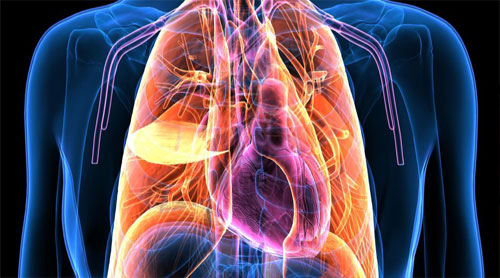2 breakthrough inventions affect the future of humanity
Cameras that can see through the body and use genetic modification methods to neutralize deadly biological weapons are considered two breakthrough inventions that affect the future of technology.
1. Magic camera is better than X-ray
Body endoscopic medical techniques have come a long way, but in the future, it can bring more breakthroughs when doctors can see through what's going on. under our skin.
Researchers have invented a new type of camera that is able to see through the structure of the body. That way, they detect light sources behind body tissues.
The first prototype was developed by researchers at Edinburgh University, England. When combined with endoscopic lights, the device can "look" into the hollow cavities inside the human body.
The endoscope is an elongated device, often fitted with cameras, sensors and lights. This is a must have for all types of medical procedures. However, if X-rays are not conducted, it is difficult to determine the exact location in the body where the endoscope is operating.
This new type of camera can overcome this by its ability to detect light sources inside the body. With thousands of photon detectors integrated inside the camera, the device can detect particles of light that are projected through human tissues.

New cameras can see through the body.(Photo: Shutterstock)
When the photon comes into contact with the body's structures, light often disperses or bounces off the tissue, and the camera's sensitivity allows it to capture the smallest traces of light.
By combining the camera-oriented light signals with scattered photons, the device can determine the location where the endoscope lights up the light inside the body.
This technique can help physicians know the exact location of organs within the body they are observing by endoscopic methods. This has an important role in diagnosing treatment.
 Illustration.(Photo: Edinburgh University).
Illustration.(Photo: Edinburgh University).
In the image above, you can see an example of light detected by a camera from a confocal microscope used in sheep lungs. The image on the left is the image seen by the new camera - it reveals the exact location of the device in the lungs.
On the right, the picture shows the scene as seen in a conventional camera, in which the sensor catches noises in the form of scattered light. But we cannot determine the location of photons when light particles emit around the structure of the lungs.
Lead researcher Kev Dhaliwal said: " This is a technology that allows us to see through the human body. The ability to see the location of a device is important for many health care applications. It is especially useful when we conduct minimally invasive methods to treat the disease . "
The project, called Proteus, studies a range of new imaging technologies to help visualize the previously unmasked 'biological secrets'. Studies focused on respiratory and lung diseases.
According to the researchers, improving vision with a new camera will help doctors visualize the location and length of the endoscope they are using. They also hope that the resolution of the photos will be improved in the future.
Surely we will not have seen this kind of magic camera appear in clinical treatment in the future, but this is really a promising step in imaging and diagnostic technology.
2. Disable deadly biological weapons
Francisella tularensis (F. tularensis) has been used as a biological weapon since World War II. Recently, scientists have used genetic modification to neutralize their toxicity.
F. tularensis causes an unpleasant disease called tularemia, with prominent symptoms such as arthralgia, myalgia and weakness. During World War II, Soviet Red Army used it to hinder German soldiers from fighting Stalingrad.
So far, the Centers for Disease Control and Protection (CDC) considers F. tularensis to be one of the most dangerous bioterrorism agents, along with anthrax, poisoning, bubonic plague, and smallpox. and viral hemorrhagic fever. However, researchers have found a way to neutralize this dangerous bacterium.
By mapping the molecular circuits of bacteria, researchers make them no longer dangerous. This method focuses on a group of genes called " the island of Francisella disease" .
 Bacteria that cause tularemia.(Photo: Futurism).
Bacteria that cause tularemia.(Photo: Futurism).
Through a series of structural, biochemical and cellular studies, the researchers determined how these 'disease-causing' genes are 'switched on' and 'turned off'. Since then, they have created a gene mutation that makes bacterial pathogens impossible to activate.
The biggest benefit of treating tularemia is that it does not rely on antibiotics. With the growing threat of drug resistance, the need to find alternative therapies for antibiotics is obvious. And any research that helps us reduce the use of antibiotics is extremely valuable.
However, this is not the first time people have found antibiotic alternatives to cure tularemia, including therapies that kill antibiotic resistant bacteria through CRISPR.
Of course, when we need it, we still have to use antibiotics, but more than that, we need to increase research into new therapies to reduce unnecessary use of drugs.
- Future breakthroughs
- Top 5 inventions can save humanity
- 20,000 scientists simultaneously warned about the fate of humanity
- 15 quirky inventions but the idea is quite interesting
- 'Brain digitization' as in Matrix: Does this scenario happen to humanity in the future?
- 4 incredible evolutionary possibilities of humanity in the future
- Surprised images of ancient people imagining about 2000
- Great inventions did not win the Nobel Prize
- 10 world-changing inventions 2008
- The important inventions of the Germans changed the world today
- The future of humanity: Living on Mars and rural skyscrapers
- The invention came from randomness
 Daily use inventions come from universities
Daily use inventions come from universities Special weight loss device helps prevent appetite
Special weight loss device helps prevent appetite 8 inventors were killed by their own inventions
8 inventors were killed by their own inventions Iran invented a motor car powered by water
Iran invented a motor car powered by water